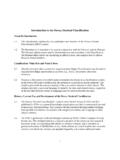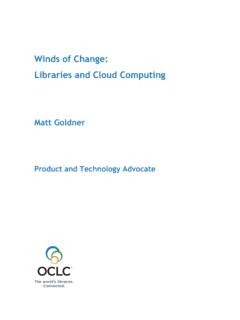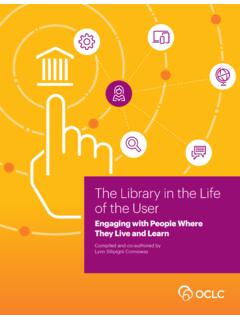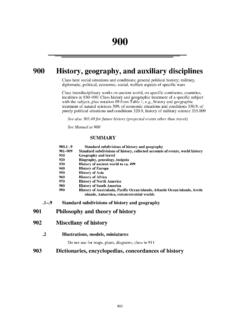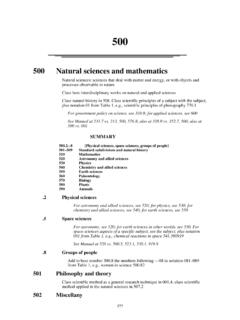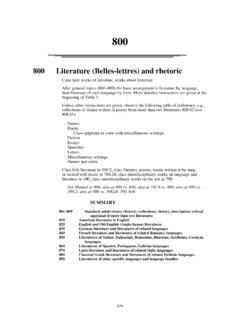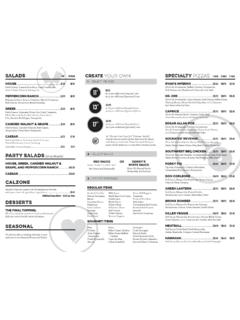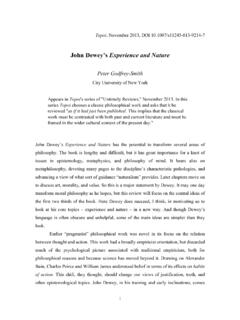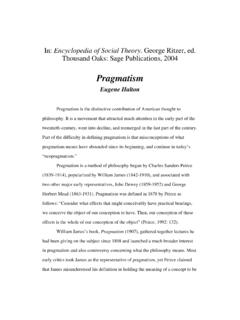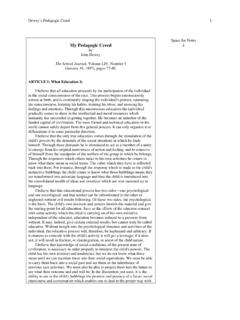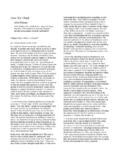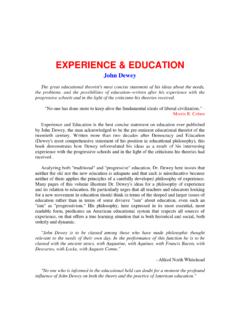Transcription of SUMMARIES - OCLC
1 SUMMARIESDDCD ewey Decimal ClassificationOCLCOCLC Online Computer Library Center, , Ohio 2003 2003 OCLC Online Computer Library Center, Inc. ( OCLC )All rights re served. No part of this pub li ca tion may be re pro duced, stored in a re trieval sys tem, or trans mit ted,in any form or by any means, elec tronic, me chani cal, pho to copy ing, re cord ing or oth er wise, with out the priorper mis sion of OCLC. DDC, dewey , dewey Deci mal Clas si fi ca tion, Web dewey , and World Cat are reg is tered trade marks and/orserv ice marks of OCLC. Li cens ing in for ma tion re gard ing the dewey Deci mal Clas si fi ca tion sys tem is avail able at Online Computer Library Center, Frantz RoadDublin, OH 43017-3395 0-910608-71-7 The three SUMMARIES are reprinted from dewey Decimal Classification and Relative Index, Edition 22 (DDC 22).
2 A Brief Introduction to the dewey Decimal ClassificationHistory and Current UseThe dewey Decimal Classification (DDC) system is a general knowledgeorganization tool that is continuously revised to keep pace with knowledge. Thesystem was conceived by Melvil dewey in 1873 and first published in 1876. TheDDC is published by OCLC Online Computer Library Center, Inc. OCLC owns allcopyright rights in the dewey Decimal Classification, and licenses the system for avariety of uses. The DDC is the most widely used classification system in the world.
3 Libraries inmore than 135 countries use the DDC to organize and provide access to theircollections, and DDC numbers are featured in the national bibliographies of morethan 60 countries. Libraries of every type apply dewey numbers on a daily basisand share these numbers through a variety of means (including WorldCat, theOCLC Online Union Catalog). dewey is also used for other purposes, , as abrowsing mechanism for resources on the DDC has been translated into over thirty languages. Translations of thelatest full and abridged editions of the DDC are completed, planned, or underway in Arabic, Chinese, French, German, Greek, Hebrew, Icelandic, Italian, Korean,Norwegian, Russian, Spanish, and Vietnamese.
4 DevelopmentOne of dewey s great strengths is that the system is developed and maintainedin a national bibliographic agency, the Library of Congress. The dewey editorial office is located in the Decimal Classification Division of the Library of Congress, whereclassification specialists annually assign over 110,000 DDC numbers to records forworks cataloged by the Library. Having the editorial office within the DecimalClassification Division enables the editors to detect trends in the literature that mustbe incorporated into the Classification.
5 The editors prepare proposed schedulerevisions and expansions, and forward the proposals to the Decimal ClassificationEditorial Policy Committee (EPC) for review and recommended is a ten-member international board whose main function is to advise theeditors and OCLC on matters relating to changes, innovations, and the generaldevelopment of the Classification. EPC represents the interests of DDC users; itsmembers come from national, public, special, and academic libraries, and fromlibrary DDC is published in full and abridged editions in print and electronicversions.
6 The abridged edition is a logical truncation of the notational and structuralhierarchy of the corresponding full edition on which it is based, and is intended forgeneral collections of 20,000 titles or less. WebDewey and Abridged WebDewey, the electronic versions of the full and abridged editions, respectively, are updatedfrequently and contain additional index entries and mapped vocabulary. Theelectronic versions and supplemental web postings are the chief sources of ongoingupdates to the DDC. On the dewey web site ( ), selected new1numbers and changes to the DDC are posted monthly, and mappings betweenselected new Library of Congress Subject Headings (LCSH) and dewey numbersare posted and NotationThe DDC is built on sound principles that make it ideal as a general knowledgeorganization tool: meaningful notation in universally recognized Arabic numerals,well-defined categories, well-developed hierarchies, and a rich network ofrelationships among topics.
7 In the DDC, basic classes are organized by disciplinesor fields of study. At the broadest level, the DDC is divided into ten main classes,which together cover the entire world of knowledge. Each main class is furtherdivided into ten divisions, and each division into ten sections (not all the numbersfor the divisions and sections have been used). The main structure of the DDC ispresented in the DDC SUMMARIES following this introduction. The headingsassociated with the numbers in the SUMMARIES have been edited for browsingpurposes, and do not necessarily match the complete headings found in first summary contains the ten main classes.
8 The first digit in eachthree-digit number represents the main class. For example, 600 second summary contains the hundred divisions. The second digit ineach three-digit number indicates the division. For example, 600 is used forgeneral works on technology, 610 for medicine and health, 620 for engineering,630 for third summary contains the thousand sections. The third digit in eachthree-digit number indicates the section. Thus, 610 is used for general works onmedicine and health, 611 for human anatomy, 612 for human physiology, 613 forpersonal health and numerals are used to represent each class in the DDC.
9 A decimal pointfollows the third digit in a class number, after which division by ten continues to thespecific degree of classification subject may appear in more than one discipline. For example, clothing hasaspects that fall under several disciplines. The psychological influence of clothingbelongs in as part of the discipline of psychology; customs associated withclothing belong in 391 as part of the discipline of customs; and clothing in the sense of fashion design belongs in as part of the discipline of the arts. HierarchyHierarchy in the DDC is expressed through structure and notation.
10 Structuralhierarchy means that all topics (aside from the ten main classes) are part of all thebroader topics above them. Any note regarding the nature of a class holds true forall the subordinate classes, including logically subordinate topics classed atcoordinate numbers. Notational hierarchy is expressed by length of notation. Numbers at any givenlevel are usually subordinate to a class whose notation is one digit shorter;coordinate with a class whose notation has the same number of significant digits;2 Brief Introduction to the DDCand superordinate to a class with numbers one or more digits longer.
